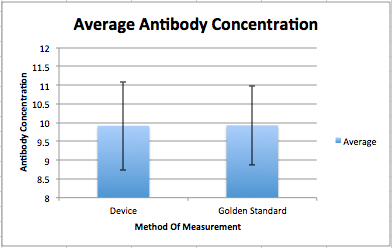BME100 s2015:Group5 9amL3: Difference between revisions
| (One intermediate revision by the same user not shown) | |||
| Line 18: | Line 18: | ||
| [[Image:BME103student.jpg|100px|thumb|Name: Wei Lu]] | | [[Image:BME103student.jpg|100px|thumb|Name: Wei Lu]] | ||
| [[Image:ME21.jpg|100px|thumb|Name: Daniela Romero]] | | [[Image:ME21.jpg|100px|thumb|Name: Daniela Romero]] | ||
| [[Image: | | [[Image:WIN_20150304_101905.jpg|100px|thumb|Name: Stephen Belikoff]] | ||
| | | | ||
|} | |} | ||
Latest revision as of 10:26, 4 March 2015
| Home People Lab Write-Up 1 | Lab Write-Up 2 | Lab Write-Up 3 Lab Write-Up 4 | Lab Write-Up 5 | Lab Write-Up 6 Course Logistics For Instructors Photos Wiki Editing Help | |||||||||||||||||||||||||||||||
|
OUR TEAM
LAB 3A WRITE-UPDescriptive StatisticsTemperature
Heart Rate
Results
AnalysisIn order to determine the relevance of the data, a T-Test of two tails and a Pearson's R correlation test was performed. The T-Test of the average temperature gave a value of 2.16259E-12, which indicated that the data collected by the Spree device was not significant because the value was less than 0.05, the margin for data significance. The T-Test of two tails of the average heart rate gave a value of 0.000345, which was also below 0.05, indicating that the heart monitoring function of the Spree device cannot properly gauge the heart rate of a human being using just a forehead-mounted sensor. It was decided to do a T-Test of two tails rather than a one-way ANOVA because a comparison being drawn between two groups and there was no predicted outcome. The Pearson R correlation test performed on the average temperature data gave a value of 0.13332247, which is close to zero, indicating that there is negligible, if any, correlation between the temperature taken with the thermometer and the Spree device. The Pearson R correlation test performed on the average heart rate gave a value of 0.828698, which is close to one, indicating a slight positive correlation between the heart rate measurement given by the pulse oximeter and the Spree device. Based on the data from these tests, it can be assumed that the data collected by the Spree device for average heart rate is accurate, to some degree, but not precise. For average temperature, the data collected by the Spree device is neither accurate nor precise.
Summary/DiscussionThe Spree has many flaws in its design and function. Though the idea of what it does is good the way it goes about has some major flaws. The first flaw was synching the Spree to the app on the iPhone. The signals were never made and when they were made all the Spree devices had the same name, so one could not differentiate of that was their Spree or if it was the people next to them. The next flaw was the measurement of body temperature. There are no number too read off, all the makers of the Spree did for this was give four levels, and those four levels did not show the exact temperatures, one would have too estimate what the number would be. The other thing that made the Spree a bad device was that it would lost connection many times during the experiment. Also other groups did have problems with the plus measurements while other did not. The solutions to the problems would come with the advancements in bluetooth and also make the sensors much more sensitive the heart beats. The last fix that could be made is too display the temperatures as numbers and not as color levels
LAB 3B WRITE-UPTarget Population and NeedThe target population for our device can be everyone but it will specifically attract any person who is against getting vaccinated. Since the device scans the bloodstream and detects if you are getting sick and releases antibiotics,it can be applied to just about anyone. Some parents don't allow their children to get vaccines because they think it can cause Autism, this device would eliminate the need for vaccines and fulfill the needs of that group. The EverChip allows poeple to live without the constant need to buy medication and get vaccinated. Problem Understanding Form
Device DesignThe units are in micrometers
Inferential Statistics
Graph
|
|||||||||||||||||||||||||||||||











